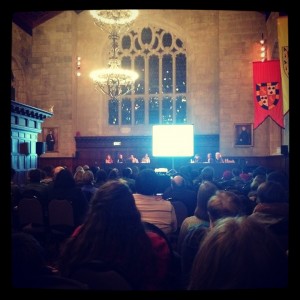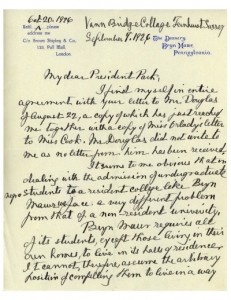The Greenfield Digital Center is currently supporting the work of three students undertaking Praxis III independent study projects exploring lesser-known aspects of Bryn Mawr College history. This week, two of those students — Grace Pusey and Emma Kioko, both Class of 2015 — are formally launching their research project, Black at Bryn Mawr. Readers can stay up-to-date with their research via the Black at Bryn Mawr blog and tumblr. Today, Grace shares the origins of the project, and its goals.
This semester Emma Kioko and I are collaborating on a Praxis III independent study course titled Black at Bryn Mawr, a project that will illuminate the history and experiences of Black students, faculty, and staff at the College. Using Bryn Mawr Special Collections as well as primary sources archived outside of the College, we are analyzing the ways in which Bryn Mawr has chosen to record, remember, and represent racism in its history. Using the archives, we are identifying spaces of both racial conflict and conversation on campus in order to develop a final project in the form of a campus walking tour and a digital historical record.

Bryn Mawr College Teach-In on Race, Higher Education, and Responsibilities in Thomas Great Hall (November 2014), via Educating Women blog.
The project was born out of several community-wide conversations that occurred after two students hung a Confederate flag in their dormitory in September 2014. Emma came up with the idea of doing a campus walking tour modeled after the Black and Blue tour at the University of North Carolina, where she spent time last summer. Because I work at the South Asian American Digital Archive (SAADA) in Philadelphia, I offered to help create a digital historical record to complement the tour. In this way, Emma and I are working to create multiple avenues to engage with Black history at Bryn Mawr. We hope the walking tour will prompt community members to look at the campus and experience the place we inhabit in new ways, and that the digital historical record will function as a complementary space of deepened historical consciousness.

Letter from M. Carey Thomas to Marion Park concerning the admission of African American student Enid Cook (1926), via Black at Bryn Mawr tumblr.
The purpose of the project is to build institutional memory of Bryn Mawr’s engagement with racism, enabling future students to hold both themselves and the College community to higher standards of awareness and accountability to racial power dynamics both inside and outside of the classroom. One thing that becomes clear from even a cursory overview of the College Archives is that incidents like the one that occurred in September are not exceptional in Bryn Mawr’s history; in fact, they are deeply embedded in it. We see the same kinds of problems recurring over and over again. A major contributing factor to this recycling of traumas is that the College community is constantly in flux: as students graduate every few years, institutional memory is wiped clean. Fruits borne of past conversations and reconciliations gather dust, or disappear.
In making the history of the College’s engagement with racism more accessible, we hope for two things: first, that the community can use our work as a resource to address this cycle of trauma, to promote dialogue that brings the community to deeper levels of understanding, and to foster sustainable collective growth; and second, to actively encourage awareness of Black experiences at the College, to center Black perspectives in how the College sees and represents itself, and to provide a metric by which Bryn Mawr can ascertain its progress over time.
We will post updates to the Black at Bryn Mawr Tumblr and WordPress blog weekly as the project develops. There will also be an opportunity to engage with the project in person at sessions planned for the community day of learning on March 18th. In April 2015 we plan to debut the walking tour and its digital record. We hope to see you then!
— Grace Pusey, Class of 2015
Pingback: Black at Bryn Mawr: The Walking Tour | Educating Women